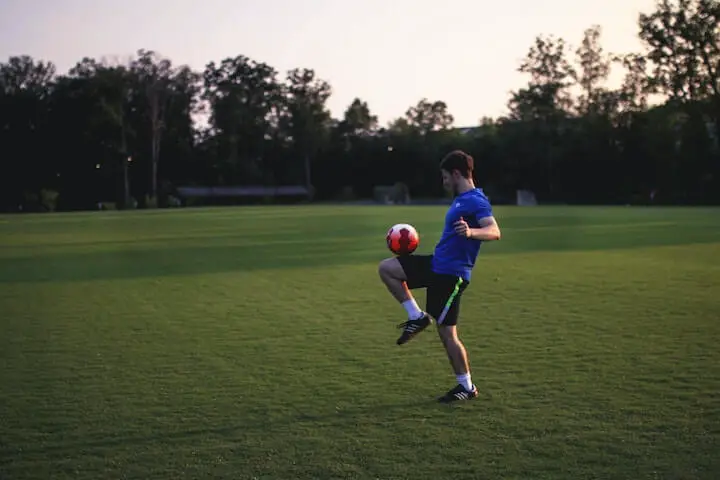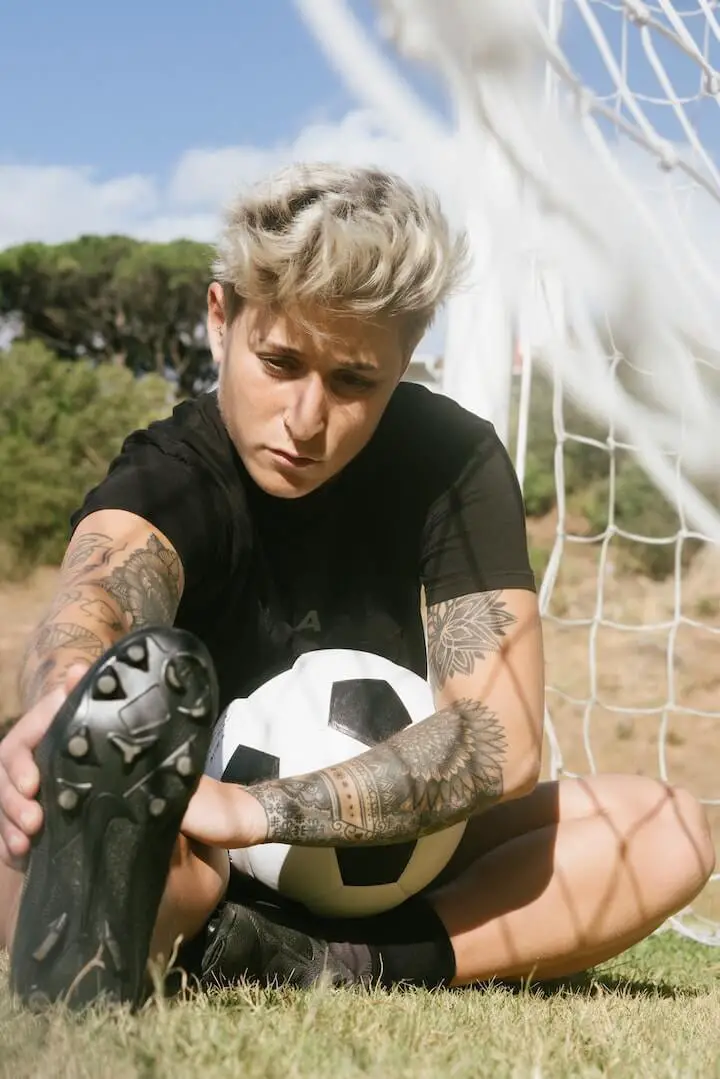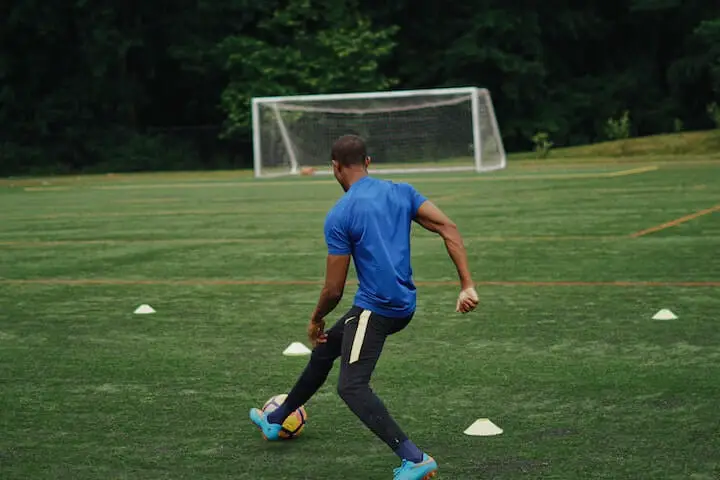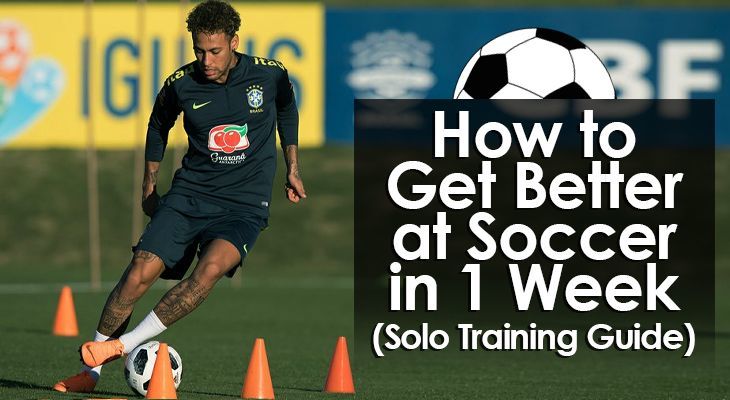How to Get Better at Soccer in 1 Week (Solo Training Guide)
Are you wondering how to get better at soccer?
It takes years of hard work and practice to make it to the very top of the game.
However, there are many things you can do to get better at soccer in just one week.
Whether you're preparing for an upcoming tryout or just want to get better for fun, follow this guide and you'll soon see improvement on your touch, control, and technique.
Improving on all these skills is key if you want to be the best player you can possibly be.
The hard work you put in should also steadily increase your stamina, strength, and speed.
Improving on these will lead to better performances out on the pitch as you remain fitter and fresher for longer.
Some of the steps will help you improve in the short-term, while others set you up for success in the long-run.
Before starting off, let's look at some of our tips to ensure you maximise the time and effort you put in out on the pitch.
Let's go!

How to Get Better at Soccer (Top Tips)
Before you begin, it's well worth coming up with a plan.
Proper planning will help make your practice more effective and efficient.
Excellent training sessions help you improve faster and achieve more in less time -- setting yourself up for success in the long run.
Working harder than your teammates by putting in the extra hours won't count for much unless you work smarter too!
Here are some tips that can help you make the most of your solo soccer training time.
1. Come Up with a Plan
It may be hard to get enough enthusiasm to sit down and plan out sessions.
But taking some time to prepare will certainly help you improve quicker than ever before.
Focused and well-planned practices help you make the most out of each session.
It helps make sure you don't tire yourself out, pick up an injury, or simply waste your time at the training ground.
In addition, planning ahead should also involve setting goals, improving your nutrition, and factoring in time to rest.
2. Eat Well and at the Right Times
As part of your planning, it is important to research on the proper diet and nutrition for your training.
Research the right foods and fluids you should take, the right quantities, and at the right times.
Aside from overall health, this helps keep you fit for longer both in mind and body.
The great thing about this is that eating and drinking well has both long and short term effects.
It improves your strength and conditioning in the short-term, which leads to better performances in the long-run.
3. Don't Forget to Warm Up and Cool Down
While it's tempting to start kicking a ball right away, it's essential that you factor in a warm up.
This helps prepare you both mentally and physically for your training session.
Don't forget to also add a cool down session to your solo training.
Proper warming up and cooling down reduces the risk of injury and helps improve mobility, athleticism and strength at the same time.
4. Speak to Your Coach
Before starting off on your week of solo training it is also a good idea to speak to your coach.
See what areas they think you should work on to improve your game.
Aside from showing them your dedication to improving, it also helps you plan out your focused training better.
In addition, your coach may be able to give you some drills to work on or some pointers on how to go about organising your training sessions.
5. Set Yourself Goals
After chatting with your coach or thought about what areas to improve on, it is well worth setting yourself some goals.
This further helps to focus your sessions.
Setting goals will also help when in researching and planning what you want to work on.
The targets you set yourself will also help motivate you during the training sessions and.
They are also meant to motivate you to put in the hard work and effort to achieve them.
6. Enlist the Help of a Friend or Teammate
While you can train by yourself, it does help to have a friend or teammate working on the same skills alongside you.
This way you can motivate each other, work on a wider range of drills and also hold each other accountable.
This also helps make sure that your concentration, commitment, and effort you put in don't drop.
On top of all this, having someone train with you makes it much more fun!
7. Make Things Fun and Enjoyable
The best way to keep yourself motivated is to make sure the individual soccer drills you plan are enjoyable to work through.
While there will undoubtedly be times when you have to sweat and suffer, it's much easier to put in the effort if you enjoy what you do.
Planning and preparing well again helps make your solo training sessions not only focussed and effective but also fun too.
8. Establish Positive Habits for the Future
While motivation and enthusiasm may come and go, habits tend to stick around and stay.
As such, coming up with a schedule, sticking to it and giving your all will help establish positive habits for the long-term.
By committing to everything - from your training programme to your diet - you set yourself up for success.
Doing so ensures all your dedication and hard work will pay off in the long-run.
Further Reading: 55 Common Mistakes Players Make on the Soccer Pitch

1 Week Solo Soccer Training Guide
In soccer, there are some skills that you have to master to make it to the very top - regardless of what position you play.
These include a bunch of things - from passing, control and first touch - to fitness, decision-making and positioning.
Aside from these, there are other skills that are more position-based.
For instance, defensive players may want to work on their tackling and heading.
Meanwhile forwards may instead prefer to focus on their dribbling, shooting and movement.
All in all, there really are lots of different areas for you to focus on depending what you want to improve on.
Try incorporating the ball with whatever skill or drill you are working on. This helps improve your touch and technique at the same time.
In addition, it's also important that you try and do drills that involve both of your feet.
Being comfortable with both feet will win you invaluable time and space out on the pitch.
To help you plan your week of solo soccer training, we've come up with some example sessions.
You can tailor them to your individual attributes and goals, varying the duration and drills as you see fit.
Coupled with your own planning, this should help make the most of your practice sessions.
Let's take a look!
Example 1: First Touch and Ball Control – 50 Minutes
Warm Up (10 Minutes)
As mentioned, it is crucial that you go through a thorough warm up before starting your training session.
During this time you can do some light running, dynamic stretches and slowly build up your speed as you go.
A thorough warm up can also help strengthen your body, increase your flexibility, and improve your agility.
This helps prepare you for the different movements in your training session.
Physical: Agility and Athleticism (15 Minutes)
With the warm up out of the way, you can now move onto improving your physique and fitness.
You can do so by with some exercises that hone your agility and athleticism.
Ideally you want to incorporate the ball as much as possible into these drills.
This improve your feel for the ball, your footwork, touch and technique all at the same time.
If you have an agility ladder or some cones, there are all kinds of great ladder drills for you to work through.
Most of these will increase the speed of your footwork, your agility, and explosiveness.
At this point you can also add in some plyometric exercises and dynamic drills.
Focus on increasing your balance and power for a better performance overall.
Technical: First Touch and Ball Control (20 Minutes)
As they are such essential skills for any player, it is a good idea to work on your first touch and ball control skills.
During this part of your training session you should look to get as many touches of the ball as possible. Concentrate on bringing it under control as quickly as you can.
Two great exercises to work on here that can be done almost anywhere are juggling and wall passes.
Besides being lots of fun, juggling greatly improves your ball-handling skills and control. It also helps hone your touch, technique and coordination.
In addition to using your feet, you can use your thighs, chest, and head, juggle against a wall or kick the ball high into the air to see if you can bring it under control when it comes back down.
Likewise, wall passes also offer loads of opportunities for you to improve as you strive to control the rebound.
With this exercise you can vary the height, power, and distance at which you kick the ball.
You can also change up how you control it and set yourself up to strike it again.
Just keep in mind to use both of your feet as you do so.
Cool Down (5 Minutes)
After having your physical and technical training exercises, it's time to cool down.
You can do so by with some static stretches and slow jogs around the pitch.
This not only reduces soreness and the risk of suffering an injury but leaves your body ready and raring to play again.
After taking in some fluids, you then want to rest and recuperate at home before getting a good night's sleep.
This way you'll refreshed for the next day's training session.

Example 2: Passing and Turning – 50 Minutes
Warm Up (10 Minutes)
As always you want to go through a thorough warm up before moving onto more taxing exercises and drills.
Physical: Strength and Speed (15 Minutes)
As a soccer player you need to be strong enough to hold off your opponents.
At the same time, you must be quick enough to get away from them with the ball still at your feet.
Before moving onto more technical ball work, it's a good idea to focus on your speed and strength. Work as well on your reaction times, acceleration, and change of direction.
Incorporate the ball as much as possible to improve your speed of footwork and ball control at the same time.
If you have some cones at hand, there are a whole host of great drills you can set up yourself. With these, you can incorporate sprints, backpedals, and quick change directions to go around them.
In this part of your solo training session you can also work through some exercises to increase your strength.
These could be everything from squats and lunges for your legs to sit ups and planks for your abs and core.
You can also do some push ups and dips for upper body and arm strength.
Technical: Passing and Turning (20 Minutes)
Another key skill to master is passing the ball with the right precision, accuracy, and power.
Just as important as this is knowing how to receive the ball, turn with it and get separation from an opponent.
With solo training there aren't all too many options for practicing passing unless you again have a wall available to you.
If so, you can practice passing the ball against the wall with one touch, aiming to hit a certain spot.
You can also place a cone on the floor which you have to take the ball around each time.
In addition you can also practice running alongside the wall as you pass the ball against it.
You can also control the ball, turn with it or take it to either side before striking it again.
If you have a friend or teammate that you are practicing with then there are all kinds of drills that can do to improve your passing and turning.
These could involve one touch passes, or short and long passing drills.
You can also incorporate exercises where you control the ball, take it out of your feet and into space before passing it back.
Cool Down (5 Minutes)
Again it is absolutely essential that you factor a cool down into your practice as this will leave you feeling fresh and ready to go again.
To avoid injuries, it is important that you listen to your body and not push yourself too hard.
These examples above should give you an idea on how to structure your solo training sessions.
It is important to not what sort of skills, both physical and technical, you should be looking to work on.
Every player however has their own attributes and goals so it really is up to you to decide how to go about your training.
What sort of exercises do you want to include? How long do you want to train for? What sort of format will it take?
Attackers, for instance, may want to focus on their shooting, finishing and dribbling.
While defenders may instead look to improve their tackling and heading skills.
What is most important is that the sessions are intense, focused, and efficient.
It's also a good idea to change things up so sessions stay fresh and enjoyable and that you learn new soccer skills each time.
We'll now quickly take a look at some technical sessions you can include over the course of the week.
The will help improve your dribbling, shooting, tackling, and heading.
For Attackers – Shooting and Dribbling Practice (20-30 Minutes)
While you can work on your dribbling and shooting skills by yourself, it is very helpful if you have a friend or teammate you can practice with.
This helps better prepare you for actual game situations.
There are however all kinds of drills that you can work on by yourself to improve your dribbling and shooting.
To increase your speed of footwork and close ball control you can set up lines of cones for you to weave around.
You can also place them at different distances and angles that you have to sprint towards and dribble around.
With shooting, you can either aim to improve your accuracy and power by striking the ball against a wall.
You can also aim at a certain part of the goal if you have one available.
In addition, you can also practice rolling shots or first time shots by kicking the ball before you and then striking it while it is moving.
When it comes to shooting practice, it is very helpful if you have a friend or teammate who you can alternate with in goal.
This then makes finishing and shooting that much more of a challenge.
It also makes it easier to practice first time shots and volleys.
To really test your dribbling skills you can also attempt to dribble around each other.
Here you can use various skills and quick footwork to take the ball around your teammate.
For Defenders – Tackling and Heading Practice (20-30 Minutes)
When it comes to tackling, you obviously need someone else that you can practice with.
With a friend or teammate you can practice all kinds of different tackling techniques from the poke and block to the shoulder challenge and slide tackle (well, maybe!).
Aside from simply trying to evade or tackle one another, you can also set up specific drills.
For instance, you can both sprint after a ball and challenge for it, each defend a goal or practice your positioning and reaction speed.
You and your friend can also alternate when it is time to practice heading the ball.
While one of you throws the balls up in the air, the other has to time their jump then either head it back or aim it to either side at a particular target.
You can also practice heading the ball by yourself - by either throwing it up the air for you to head or heading the ball against a wall.
Remember to check with your local league and their guidelines when it comes to heading the ball.
Not all age groups are now recommended to practice the skill.
Outside of the training grounds, it's a good idea to watch, read and learn more about soccer when you get home.
This will help you better understand what positions defenders and attackers take up on the pitch.
By watching soccer matches or videos online you'll also gain further ideas on how to structure your solo training sessions.
These are also great sources of motivation as you see cool skills and tricks you want to learn.
Conclusion
For those of you wanting to learn how to get better at soccer, I hope this guide helped!
Training harder, planning smarter, and establishing positive habits sets yourself up for success.
Both in the short-term and in the long-run.
To maximise your training, keep your solo soccer sessions intense, focused, and fun.
By following the above tips and using the example sessions as a template, you can really tailor your practices to your individual attributes, needs and goals.
By dedicating and committing yourself to getting better, you will surely see improvements in your game and performances in no time at all.
Further Reading: 28 Soccer Training Tips and Secrets to Master the Pitch

